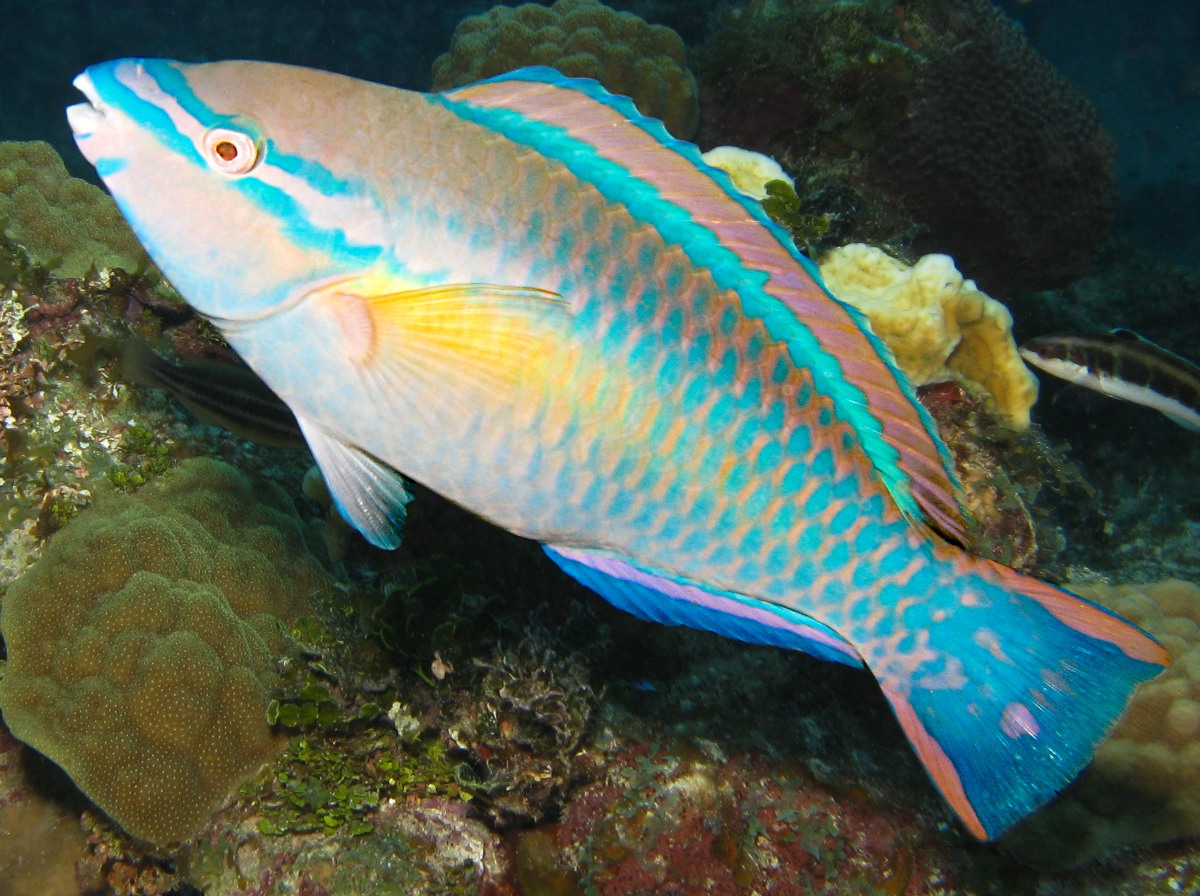Beautiful species of Parrotfish in St. Barth
St. Barthélemy, a Caribbean island known for its vibrant marine biodiversity, is home to several species of parrotfish. These fish play an essential role in maintaining the health of coral reefs by grazing on algae, preventing overgrowth that could suffocate corals. Parrotfish are also known for their striking coloration and the ability to change sex throughout their life cycle. Here are some of the most notable parrotfish species found in the waters surrounding St. Barth:
1. Stoplight Parrotfish (Sparisoma viride) | Shop

- Appearance: Named for its distinctive color changes, the stoplight parrotfish transitions through different color phases. Juveniles are reddish-brown with white stripes, while intermediate-phase fish develop a mix of green, yellow, and red hues. Terminal-phase males are primarily bright green with yellow patches near the pectoral fins.
- Behavior: These parrotfish are active grazers, using their beak-like teeth to scrape algae from coral and rocky surfaces. They contribute significantly to sand production by excreting fine coral particles after digestion.
- Habitat: Found in coral reefs, rocky outcrops, and seagrass beds, typically at depths of 3–30 meters.
2. Queen Parrotfish (Scarus vetula)

- Appearance: Queen parrotfish are known for their striking blue and green coloration, with adult males displaying electric blue bodies and distinctive bright yellow or pink markings. Females and juveniles tend to have more subdued brownish tones.
- Behavior: This species primarily feeds on algae growing on coral, contributing to reef maintenance. At night, queen parrotfish are known to secrete a mucous cocoon around themselves, possibly to deter predators.
- Habitat: Typically found in reef environments, often at depths ranging from 5 to 25 meters.
3. Princess Parrotfish (Scarus taeniopterus)

- Appearance: This species is characterized by its slender body, with colors transitioning from brownish tones in juveniles to vibrant blues, greens, and purples in adults. A defining feature is the dark-edged scales and vertical striping patterns seen in some phases.
- Behavior: Like other parrotfish, princess parrotfish help keep coral reefs healthy by feeding on algae. They are usually observed in small groups grazing on the reef.
- Habitat: Found in shallow coral reefs and rocky areas, usually at depths of 2–20 meters.
4. Redband Parrotfish (Sparisoma aurofrenatum)
- Appearance: Named after the distinct red band that runs from the snout to below the eye, this species exhibits a mix of colors across different phases. Juveniles have a mottled brown appearance, while adults display a more vibrant greenish-blue hue with reddish fins.
- Behavior: Redband parrotfish are frequently seen scraping algae from rocks and corals, playing a crucial role in controlling algae growth on reefs. They are typically more solitary than other parrotfish species.
- Habitat: Found in coral reefs, rocky areas, and seagrass beds, typically at depths of 3–25 meters.
5. Redtail Parrotfish (Sparisoma chrysopterum)
- Appearance: This species has a combination of red, green, and brown tones, with a distinctive red tail fin that gives it its name. Juveniles tend to be darker and less colorful, transitioning to more vibrant hues in adulthood.
- Behavior: Redtail parrotfish spend much of their time grazing on seagrasses and algae-covered rocks. They play an essential role in maintaining a balanced reef ecosystem.
- Habitat: Typically found in coral reefs, seagrass beds, and sandy-bottomed areas, at depths of 3–30 meters.
Ecological Importance of Parrotfish in St. Barth
Parrotfish are vital for the health of St. Barth’s coral reef ecosystems. Their constant grazing prevents the overgrowth of algae, which could otherwise suffocate coral colonies. By feeding on dead coral and excreting the digested material as sand, they also contribute to the formation of sandy beaches and help maintain the structural integrity of the reef.
Parrotfish populations are often threatened by overfishing and habitat destruction, so conservation efforts in the region focus on protecting these essential species. Marine reserves and sustainable fishing practices help ensure that parrotfish continue to thrive in St. Barth’s waters.
For visitors, snorkeling or diving in the island’s reefs provides an incredible opportunity to observe these fascinating fish up close, offering a glimpse into the dynamic and colorful underwater world of the Caribbean.








